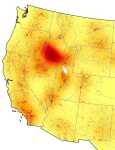BLM proposes wildfire prevention changes

The Bureau of Land Management's Boise District Office is offering a series of open houses to provide the public an opportunity to comment on the Paradigm Fuel Break Project Draft Environmental Assessment (EA).
The open house in Mountain Home will be held on Feb. 4 at the Elks Lodge, 325 S. 3rd West St., from 6-8 p.m.
"BLM is proposing to develop a network of fuel breaks along approximately 187 miles of routes and roadways located east of Boise between Blacks Creek Road and Glenn's Ferry, which is an area with frequent large fires," said Project Manager Mike McGee.
"The purpose of the fuel breaks is to provide firefighters with areas where they can safely implement suppression actions and increase the likelihood of containing wildfires. The fuel breaks will also reduce the risk to life, property and natural resources," said McGee.
The pilot project is expected to last ten years for full evaluation. If successful, it could be a model for all other public lands in the U.S.
Under the National Environmental Policy Act (NEPA), BLM has analyzed a range of alternatives and is seeking public review and comment regarding the analysis of effects to the human environment. Comments from the public should be received by the BLM by Feb. 24.
The Draft EA may be accessed on the BLM website at: https://www.blm.gov/epl-front-office/eplanning/nepa/nepa/nepa_register.do.
The proposals on the table now are the result of recommendations made in 2011 during a fire symposium that brought together land owners and government agencies to look at better ways to deal with wildfires, especially in this area, which has one of the highest rates of wildfire incidents in the country. It has taken this long for the proposals to work their way through the NEPA process.
Tedd Hoffman of Mountain Home was chairman at that time of the Resource Management Plan subgroup of the Bureau of Land Management's Regional Advisory Council.
In that capacity, he helped put together a symposium that brought experts in fire management together for a two-day series of discussions and workshops designed to develop a pilot program that would focus on reducing the frequency of and the extent of damage from wildfires.
Hoffman said at the time that the ideas generated during the symposium would "result in a plan we can implement that will cut down significantly on the loss of resources due to range fires."
No area in the country has been hit as often or as hard by wildfires as the Snake River Plain. It has resulted in a loss of habitat, forage for cattle and wildlife, posed major threats to endangered species and damaged natural resources throughout the area.
In Elmore County alone, nearly one third of the county has burned in the last 30 months, an area larger than some small states.
Hoffman and other experts had propose the development of "green strips" that would act as natural firebreaks to limit the size of rangeland wildfires, most of which are caused by lightning (most human-caused fires occur adjacent to the interstate and Highway 20).
One of the methods would be to seed areas with fire-resistant plants, such as forage kochia, he said. Although not a native plant, it is cheap, seeds quickly and is fire resistant, Hoffman said. An area just west of Mountain Home and north of the interstate has some of the plant there, and no major wildfires have burned through the area in recent years.
It also "is a great source of protein" for cattle and wildlife that can sustain heavy grazing, he said, and more importantly, may also be able to form a weed barrier. It tends to outcompete cheatgrass, which is a major source of the "fuel" for area fires and interferes with better forage sources for herbivores.
Furthermore, he said in an interview after the 2011 symposium, it can help restore sagebrush stands. "All the plants that require a sage steppe ecosystem," he said, "all depend on sagebrush. But there's a lot less than there was (largely due to fires) and it may not be there in 20 years." What is left, he said, tends to be in concentrated stands, and when sagebrush burns, it burns at very high temperatures. In a concentrated stand, those temperatures can actually sterilize the soil, making it difficult for anything to grow there.
If the sagebrush disappears "there won't be much of a chance of growing other grasses again," he said. The result, he said, could be an ecological catastrophe.
The plan that was developed calls for creation of "green strips" as one of several ways to control range fires.
Additional fire breaks also will help slow fires and give firefighting crews lines to fight on.
"We have to begin acting now," Hoffman said in 2011. "We need to ultimately be spending money less on fire trucks and more on ways to prevent fires. We need to seed and put in fire breaks so when there is a fire, it doesn't get out of control" and burn hundreds of thousands of acres, he said.
The plan being presented for comment by the public is based on the work of the local fire seminar group.
